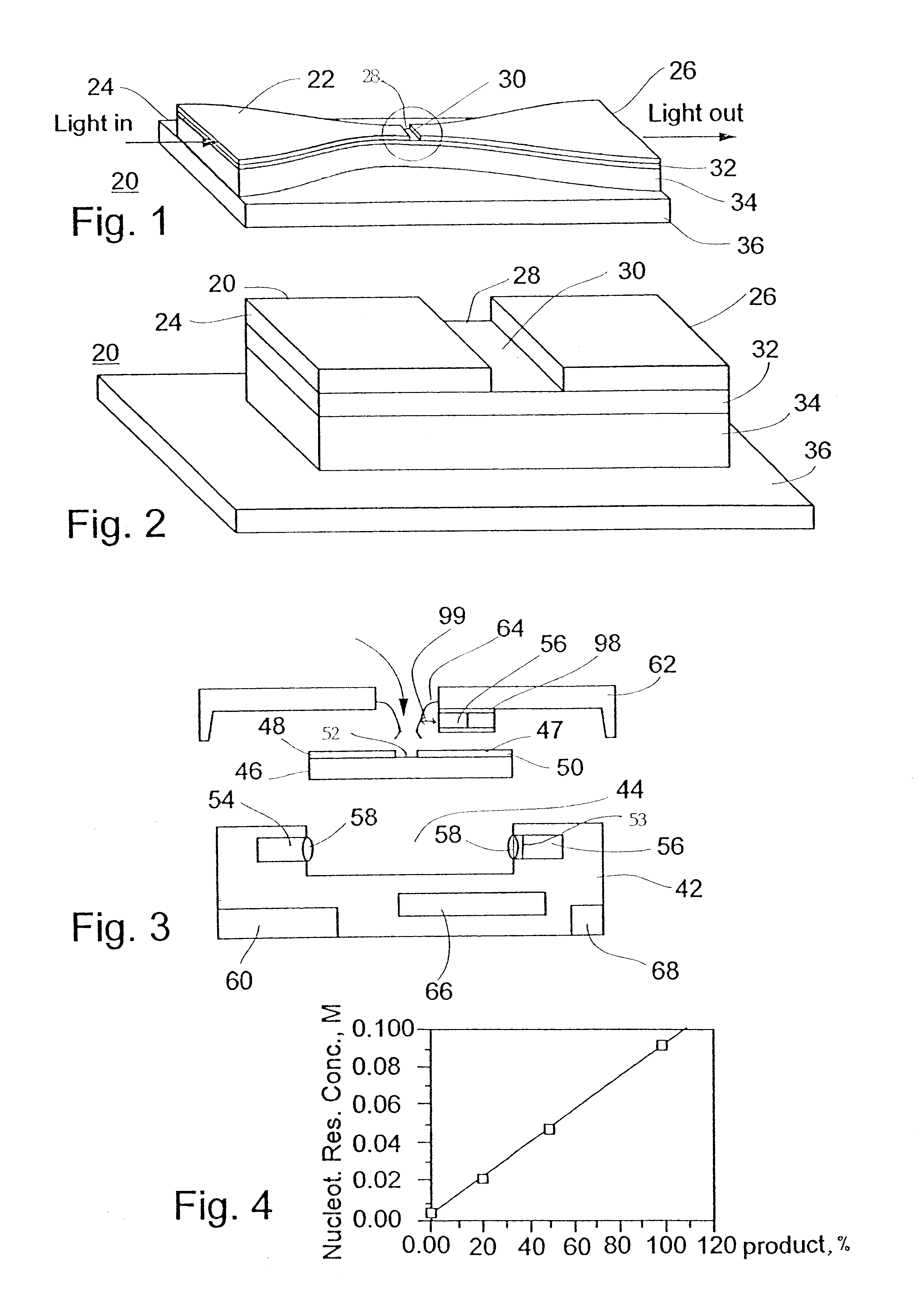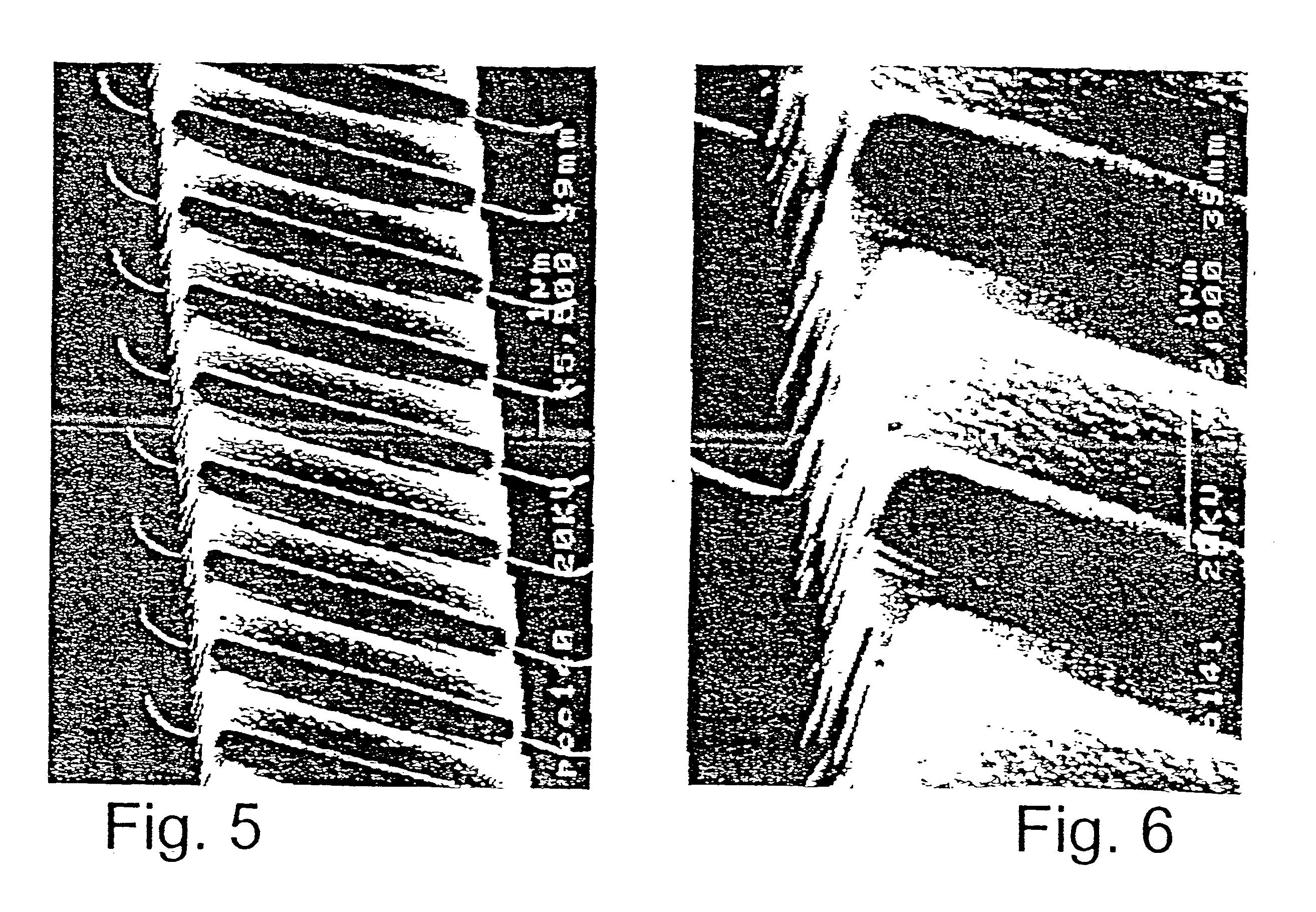Method, chip, device and system for effecting and monitoring nucleic acid accumulation
a nucleic acid and accumulation technology, applied in the field of nucleic acid amplification methods, can solve the problems of inability to fully realize the effect of immobilized oligonucleotides, and difficult to achieve the effect of amplification
- Summary
- Abstract
- Description
- Claims
- Application Information
AI Technical Summary
Problems solved by technology
Method used
Image
Examples
example 1
Theoretical Considerations
The following concerns some calculations related to nucleic acid accumulation within the microcavity of the analyzing chip according to the present invention.
Assume that the bottom face of the optical microcavity is 10 square micrometers and that its volume is 5 cubic micrometers or 5.multidot.10.sup.-15 liter. Further assume that the surface density of oligonucleotide is 10.sup.5 molecules per 10 square micrometers and that all of which are immobilized to the bottom face of the microcavity, then the volume concentration of the oligonucleotide is 10.sup.5 molecules per 5 cubic micrometers, or 3.0.multidot.10.sup.-5 M.
Assume that the oligonucleotide is 42 residues long, then the concentration of nucleotides in the microcavity is 1.4.multidot.10.sup.-3 M. Assume that the PCR product is 1500 base pairs long and that all of the oligonucleotide molecules present in the microcavity were extended and now appear as a part of double stranded 1500 base pairs long mol...
example 2
Waveguides
FIGS. 5-8 show scanning electron micrographs of waveguides formed according to the present invention. The waveguide of FIGS. 5-6 include a plurality of cavities. The waveguides shown in FIGS. 7-8, each includes a single microcavity. The waveguides shown in the upper part of FIG. 7, each includes a microcavity designed to reflect light arriving thereat along an L-shaped optical path of the waveguide. An enlargement of that microcavity is shown in FIG. 8. The waveguides shown in the lower part of FIG. 7 are linear, each includes a SiO.sub.2 coated microcavity of a variable length (lighter appearance).
These waveguides were manufactured in accordance with the teachings of Dan Haronian in "In-plane degree of freedom optical waveguide displacement sensors based on geometrical modulation", published in 1998 in Sensors and Actuators A, 69:217-225, and in "Suspended optical waveguide with in-plane degree of freedom for microelectromechanical applications", published in 1998 in Elec...
example 3
PCR Reaction in a Microcavity of a Waveguide
Attachment of Oligonucleotide (5 '-propylamine Modified 42-mer):
Epoxide Modification: The Silicon oxide surface of silicon chips was modified with gamma-glycidoxypropyl trimethoxy silane (GPTMS, see FIG. 10) as follows: Silicon oxide-coated silicon chips were washed in water and ethanol, passed twice through flame of a bunsen burner and checked for wetting of the surface by water. The chips were immersed in a solution of GPTMS in water (4%, pH 5.5-5.8) and heated at 90.degree. C. for 30 minutes. The chips were water washed and used without delay.
Coupling of Primer Oligonucleotide to the Chip Surface: The oligonucleotide primer (42-mer, 5'-amino modified, 5'-H.sub.2 N-(CH.sub.2).sub.6 -PO.sub.4.sup.2- -AATGCTTAAGCCATGGCATATGAATTAACCCT CACTAAAGGG-3', SEQ ID NO: 1, 30 .mu.M, 4 .mu.l) in 0.5 M Na-carbonate was applied to the epoxide-modified chips (4.times.4 mm) placed in a humid closed chamber and kept at 40.degree. C. overnight. Unreacted ep...
PUM
| Property | Measurement | Unit |
|---|---|---|
| volume | aaaaa | aaaaa |
| temperature | aaaaa | aaaaa |
| temperature | aaaaa | aaaaa |
Abstract
Description
Claims
Application Information
 Login to View More
Login to View More - R&D
- Intellectual Property
- Life Sciences
- Materials
- Tech Scout
- Unparalleled Data Quality
- Higher Quality Content
- 60% Fewer Hallucinations
Browse by: Latest US Patents, China's latest patents, Technical Efficacy Thesaurus, Application Domain, Technology Topic, Popular Technical Reports.
© 2025 PatSnap. All rights reserved.Legal|Privacy policy|Modern Slavery Act Transparency Statement|Sitemap|About US| Contact US: help@patsnap.com



